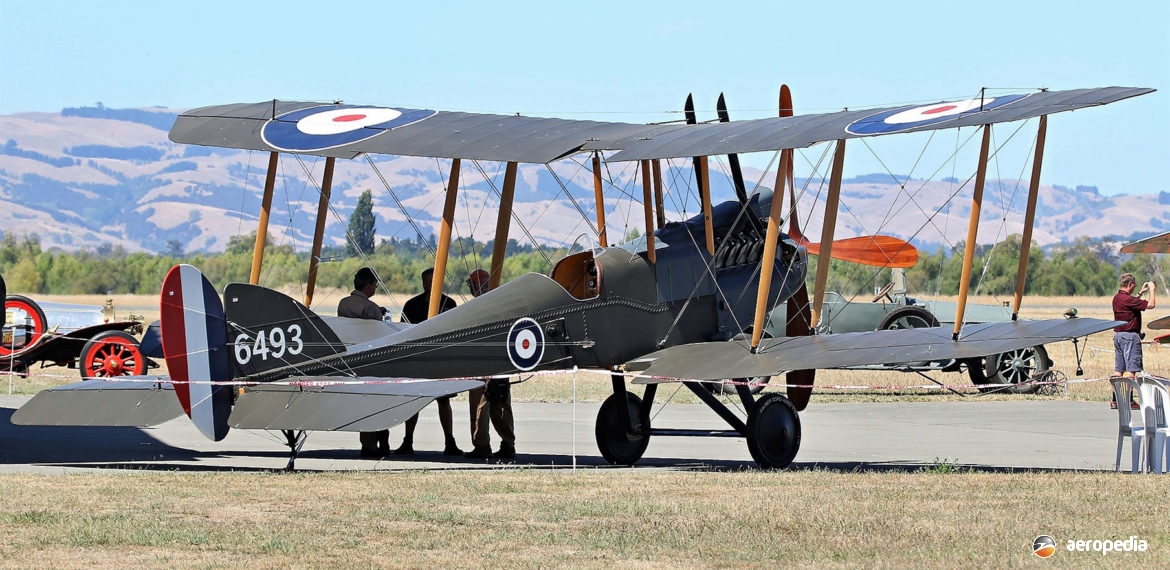Photograph:
RAF Be.12 ZK-ZEP (c/n 0249) at Masterton, NZ in 2017 (Brett McCusker)
Country of origin:
United Kingdom
Description:
Single-seat fighter biplane
Power Plant:
One 104 kw (140 hp) RAF 4a 12-cylinder VEE air-cooled engine
Specifications:
- Wingspan: 12.42 m (40 ft 9 in)
- Length: 8.3 m (27 ft 3 in)
- Height: 3.65 m (12 ft)
- Max speed at 3,810 m (12,500 ft): 169 km/h (105 mph)
- Max speed at 1,981 m (6,500 ft): 156 km/h (97 mph)
- Max speed at 2,438 m(8,000 ft): 151 km/h (94 mph)
- Max speed at 3,048 m (10,000 ft): 146 km/h (91 mph)
- Time to 914 m (3,000 ft): 5 mins 50 sec
- Time to 2,743 m (9,000 ft): 27 mins
- Time to 3,658 m (12,000 ft): 47 mins 30 secs
- Fuel capacity: 259 litres (57 imp gals)
- Endurance: 3 hours
- Empty weight: 730 kg (1,610 lb)
- Loaded weight: 1,055 kg (2,327 lb)
Armament:
Two 7.69 mm (0.303 in) Lewis machine guns; bomb load of two 51 kw (112 lb) or sixteen 7 kg (16 lb) bombs
History:
The BE.12 was a single-seat fighter developed in 1915. The prototype was a re-built BE.2c (serial 1697), being a two-bay equal-span biplane with a Royal Aircraft Factory 4a engine. By August 1916 two RFC Squadrons had been equipped with the type. However, the aircraft suffered from the same ineffectiveness as the BE.2, a lack of manoeuvrability, and was doomed to failure from the beginning. Subsequently the BE.12 was modified by the installation of the wings of a BE.2e, becoming known as the BE.12a.
The total number built is not known but contracts were let for a total of 600, and 468 are known to have been issued to units. Many saw service in the Palestine region with No 67 Squadron RFC, most of the personnel of which were Australians. Other units in Palestine included No 23 Training Squadron in Egypt, and Nos 14 and 144 Squadrons. The types success was in Macedonia, where Nos 17, 47 and 150 Squadrons RAF operated the type. A few were still in service at the time of the Armistice. The type also saw service with six Home Defence Squadrons in the United Kingdom.
Production mainly took place at the Coventry Ordnance Works, Daimler Co Ltd and the Standard Motor Co Ltd, all at Coventry, UK. The series was regularly operated by Nos 1 and 4 Squadrons AFC in the general-purpose scout and fighter roles. Armament varied, some having two Lewis guns, one on each side of the fuselage and angled to clear the propeller. This was improved when the Vickers-Challenger synchronising mechanusm was installed, the aircraft then being fitted with a Lewis gun on the starboard side, or a rearward firing Lewis gun on the port side. Its bomb load comprised two 51 kg (112 lb) bombs or up to sixteen 7 kg (16 lb) bombs.
Construction was almost identical to the BE.2, having two-bay wings with wooden main spars and ribs, wire-braced and fabric covered. The fuselage was a wire-braced box girder with fabric covering but it had a plywood top decking in front of the cockpit. The fin and rudder were fabric covered steel tube. Fuel was contained in a gravity tank installed under the port upper wing. A Vickers machine gun with Vickers interrupter gear was carried on the port side of the fuselage but some aircraft had two Lewis machine guns on mountings firing forward.
One [serial 6610] flown by Lieutenant LP Watkins of No 37 [Home Defence] Squadron on 17 June 1917 shot down the Zeppelin L.48. The BE.12a was produced and had horn balances on the ailerons on the upper wing. The Home Defence model, known as the BE.12b, was first seen in 1917 and had a 149 kw (200 hp) Hispano-Suiza engine, a radiator on the front and a large head-rest for the pilot. It had two Lewis machine guns on a mounting which permitted the pilot to fire upwards or forwards over the top wing; and some were fitted with bomb racks.
Eleven examples are known to have served with Nos 1 and 4 Squadrons, AFC. Most of these were built as the Be.12 but were later converted to Be.12a standard. Most of the Australian operated aircraft were Daimler built and serials known include: A562, A566, A575, A6311, A6321 which was driven down by enemy aircraft and captured, A6322 shot down near Tel El Sherie on 25 June 1917, the pilot being killed, A6323, A6328, A6329, A6338 and A6347. Surviving aircraft were returned to the RAF, as it then was, at the end of World War I.
In May 1917 No 1 Squadron AFC was operating in the Gaza area in the Middle East and initially received two BE.12s in order to carry out the missions tasked to it but these aircraft were soon deemed ineffective in that role. However, the pilots appreciated the synchronised machine gun firing through the propeller and their ability to climb quickly. Eventually they were used to escort BE.2s during reconnaissance missions pending the arrival of Bristol Fighters, which later took up escort duties.
On 6 November 1917 Austalian pilots Ron Austin and Ross Smith in BE.12s were flying over Sheria, between Gaza and Beersheba, when they were attacked by three Albatros D.IIIs but managed to escape and get back over their own lines with difficulty, the aircraft being badly shot up. Afterwards the BE.12s were used to carry cameras to photograph enemy positions and the photographs obtained were used in the preparations of maps.
In April 2015 The Vintage Aviator Limited of Wellington, NZ, known for the construction of reproductions of World War I aircraft and engines, completed a BE.12-1 (c/n 0249) which became ZK-ZEP on 23 April 2015, registered to TVAL and initially based at Masterton, NZ.

